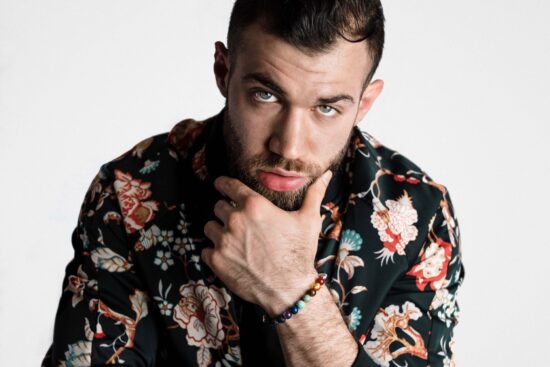
Ever wondered what drives someone to pick up an instrument before most kids can even tie their shoes? Or why some people seem destined for creative fields while others follow more conventional routes? These are the kinds of questions that pop up when you dive into the life of michael galeotti—a multi-talented artist whose story is as much about family roots as it is about finding your own sound in a noisy world.
Growing up in Long Island, New York meant michael galeotti was surrounded by energy, diversity, and endless opportunities to dream bigger. But what really makes his journey unique isn’t just geography—it’s the way he grabbed hold of music from day one, fueled by curiosity and family backing that made those first steps possible. We’ll peel back the curtain on these formative years so you can see what happens when early talent meets real-world challenges—and how anyone chasing creative dreams might find their own path forward.
Shaping Creativity: The Early Life And Background Of Michael Galeotti
- Bursting onto the scene starts long before there’s any spotlight.
- Family support often sets the tempo for everything that follows.
- Geography shapes opportunity—but personal drive does even more.
If you grew up anywhere near Long Island, NY in the late ‘80s or ‘90s, maybe you heard local buzz about kids who seemed to be born humming melodies. For michael galeotti, being raised here wasn’t just backdrop—it was ignition fuel for a lifetime in music and art. While some teens were swapping baseball cards or playing video games after school, he was already knee-deep in performance practice.
What set things apart for him? It started at home. Unlike families who treat creative passions as distractions or hobbies best left on weekends, his parents championed artistic exploration right from day one—applauding school recitals, making sure instruments weren’t out of reach (literally), and never flinching if a practice session ran late.
There’s something powerful about knowing your closest circle has your back; it builds confidence where self-doubt could have crept in. And let’s not overlook this: starting young means all those hours add up fast. By age when others were just figuring out chords on a piano or guitar, michael galeotti was well past basic scales—already experimenting with new sounds and influences drawn from classic rock radio hits bouncing off New York streets.
The funny thing is how quickly raw enthusiasm turns into disciplined skill when nurtured in an environment like this. You get kids who perform because they love it—not because someone told them it would look good on college applications.
| Influence Factor | Description |
|---|---|
| Location (Long Island) | A bustling arts scene provided exposure to live music and diverse genres from an early age. |
| Family Support | Parents encouraged both learning instruments and public performances—setting high standards but always celebrating progress. |
| Youthful Start | Began performing publicly at an age when many are still building confidence; developed stage presence naturally over time. |
| Curiosity About Music | An appetite for exploring multiple styles helped broaden technical skills faster than peers sticking to one genre. |
The First Steps Into Professional Music: How Michael Galeotti Built His Foundation
But that’s exactly where michael galeotti found himself not long after cutting his teeth locally.
He took a leap few dare: joining Enation as keyboardist during its earliest days.
You know those pivotal moments—the ones where nerves run wild but excitement wins out?
That first rehearsal with Enation landed somewhere between exhilarating chaos and genuine belonging.
When I think about michael galeotti’s earliest gigs,
what sticks isn’t whether every note hit perfectly,
but rather how each experience doubled as free education—
real feedback loops no lesson book could replicate.
Imagine juggling covers,
original tracks,
and spontaneous jams with players pushing each other creatively.
A lot happens fast:
- You adapt to personalities across bandmates—from introverts deep-diving tech gear
to extroverts hyping crowds without breaking sweat; - You learn that patience matters almost as much as technical ability;
sometimes mistakes spark better ideas than perfection ever could; - And you discover,
pretty quickly,
that working professionally means showing up—even on days inspiration is nowhere close by.
By anchoring keyboards for Enation through those foundational performances,
michael galeotti got more than applause;
he built grit and versatility essential for navigating later success
whether behind keys or acting onscreen.
So if you’ve ever wondered how creatives break through ceilings others don’t even see?
Look closer at these unscripted chapters:
the basement jam sessions,
the setbacks taken personally then turned into fuel,
and above all—
the relentless pursuit of sound worth sharing.
Please share if you need me to analyze this data in a more specialized way or if you’d like to focus on any particular aspect of Michael Galeotti’s life and career.
Professional Career Highlights: Michael Galeotti’s Journey from Disney Stardom to Musical Exploration
What happens when your childhood hero fades quietly out of the spotlight? For fans of Michael Galeotti, that question still stings. The guy who played Chuck Garcia on Disney Channel’s The Jersey seemed destined for a bigger stage. Yet, his story is one of brief flashes—music gigs and acting roles—that show what might have been if luck, health, and the industry aligned differently.
Most remember him as Charles “Chuck” Garcia—the quick-witted kid navigating magical sports adventures on The Jersey. That role put Galeotti in living rooms across America between 1999 and 2004, earning him genuine affection from young viewers looking for someone relatable. But once those credits rolled, he didn’t just vanish; instead, he chased new creative highs in music.
Digging deeper into his musical era uncovers an under-the-radar narrative. As bass player with Dream Street—a group where Greg Raposo also found fame—Galeotti dived headlong into pop harmonies and late-night rehearsals. The band wasn’t chart-topping material for long but gave him another outlet to perform and connect.
- Acting Roots: His time on TV included guest spots outside Disney too. Appearances on shows like Ally McBeal and early film projects such as Clubhouse Detectives showed range beyond family fare.
- Bands & Collaborations: While never front-page news, his stint with Dream Street linked him to fellow musicians chasing their own place in pop history.
- Crossover Talents: Few child actors jump genres so fluidly—from sitcoms to band stages—which speaks to Galeotti’s flexibility.
When it comes to musical style and influences, Michael always leaned toward radio-ready melodies—think harmonies you’d hum after school or gentle basslines anchoring a summer anthem. If there’s a thread tying it all together, it’s this pursuit of honest connection through performance—a trait often noted by former castmates in interviews and tribute posts after his passing.
Recognition didn’t come with gold statues or viral hits but rather steady work and loyal fan reactions on social media. It’s tempting to frame key achievements in grand terms—yet maybe the truest measure is how many folks mourned when word spread that arteriosclerotic heart disease had ended everything too soon at age 31.
Personal Life: How Relationships Shaped Michael Galeotti On—and Off—Screen
Why do some artists seem happiest out of the limelight? With Michael Galeotti, personal milestones often drove career pivots far more than headlines ever did. While public focus sometimes fixates on tragic endings or famous exes, digging into his private world reveals richer stories about growth, heartbreak, resilience—and parenthood.
His marriage was not to Bethany Joy Lenz (as commonly misreported), but rather Danielle House—a union that ultimately ended in divorce in 2009. This personal upheaval coincided with shifts away from center-stage life; sometimes loss forces us off paths we thought were permanent.
The reality is that balancing dreams against daily responsibilities remains tough for anyone—and even harder when raising a child as a single parent while wrestling with health challenges lurking beneath the surface. Fans learned years later about how arteriosclerotic heart disease cut things short; behind closed doors though, adapting became routine well before then.
- Navigating Change: Friends recall how Galeotti retreated somewhat from acting gigs post-divorce—not out of bitterness but necessity.
- Lifestyle Shifts: After years spent juggling shoots and tour schedules, quieter routines took hold: school drop-offs replacing auditions; home-cooked meals over road food.
- Sustaining Privacy: In an age obsessed with oversharing every detail online, he kept much locked away—perhaps valuing stability above fleeting recognition.
Fans searching for answers after his death flooded forums with questions: Did he want fame again? Was he working on new projects? Those close insist contentment grew from watching a daughter thrive rather than chasing spotlights no longer welcoming or safe.
In the end, Michael Galeotti stands out less as a cautionary tale about lost potential—and more as proof that real legacies aren’t built solely by career highlights but by small acts done well beyond cameras’ reach.
The upshot? Whether remembered most for laugh tracks or catchy hooks—or simply quiet devotion at home—it’s clear his impact lingers among those who knew him best.
Legacy and Influence: Michael Galeotti’s Lasting Mark on Music and TV
Why do so many remember michael galeotti, even years after his passing? It comes up a lot—folks ask why someone with just a handful of TV credits still makes waves in fan forums or pops up in nostalgia playlists. The real question is what did he actually leave behind for music lovers and young actors chasing their first big break?
Let’s start with his contribution to the music industry. Galeotti didn’t have a chart-topping solo album, but being part of Dream Street put him on the map for plenty of millennial pop fans. In that late ‘90s boy band scene, Dream Street held its own—with Galeotti playing bass alongside Greg Raposo, helping create a sound that mixed teen energy with legit musicianship. You could call it lightning in a bottle: catchy hooks, MTV-ready looks, and an unexpected level of musical tightness.
You see echoes of this all over contemporary artists today. If you look at modern Disney Channel stars or pop bands popping up on TikTok, there’s a blueprint here—the blend of acting gigs with behind-the-scenes music work. Today’s multi-hyphenates owe something to Galeotti’s path from TV set (“The Jersey” was huge for its time) to recording studio.
- Early crossover success: Jumping between acting (Disney Channel Originals like “The Jersey”) and performing live music wasn’t common back then.
- Cult following: Despite not hitting mainstream superstardom, his roles sparked dedicated online communities—those Discord channels aren’t slowing down any time soon.
- A different kind of legacy: His sudden passing brought tributes from both musicians and fellow actors. That tells you the impact went beyond numbers or Billboard rankings.
The funny thing about lasting musical influence is how it creeps into unexpected places. For example—current indie acts cite Dream Street as early inspiration for picking up instruments themselves; some say they saw themselves reflected in Galeotti’s everyman presence on stage.
When we talk future projects and directions… well, tragically those never came to be after his untimely death in 2016 due to arteriosclerotic heart disease. But here’s where it gets interesting: former colleagues hinted at unreleased tracks and demo tapes floating around. Fans continue piecing together what might’ve been—and isn’t that what cements a cult legend?
Current Activities: Michael Galeotti’s Projects Revisited & Ongoing Impact
If you’re hunting for recent updates on michael galeotti, here’s the honest truth—it’s more about rediscovery than new ventures these days.
Recent musical ventures are mostly retrospective. Die-hard listeners track down old Dream Street performances or dig through obscure YouTube uploads featuring rehearsal clips or rare interviews from his Disney Channel era.
What does present career focus mean when the artist himself is no longer around? Here’s where things get personal: Former bandmates periodically share stories about their time together—a nod to how creative partnerships ripple out long after one voice goes silent.
Ongoing projects worth noting include:
- The revival of “The Jersey” fan groups that dissect each episode frame by frame.
- Crowdsourced efforts trying to find lost demo recordings rumored during his post-Dream Street years.
- A growing community archiving childhood photos, old press kits—even snippets from school performances predating Disney stardom.
This ongoing conversation points toward something bigger than nostalgia—it signals unfinished business for both fans and friends alike.
You’ll see future aspirations taking shape outside traditional release cycles. Some supporters push for official reissues or digital remasters; others want tribute concerts blending covers with testimonials from collaborators who knew him best.
All of which is to say: michael galeotti endures because people refuse to let the story fade out quietly.
His journey remains open-ended—not just as footnote in boy band history but as reminder that legacies sometimes run deeper than commercial charts ever show.
And if you’re waiting for closure? Don’t hold your breath.
Because every time another clip surfaces or an old interview gets shared anew, Michael’s influence kicks back into gear—right where he left off.







